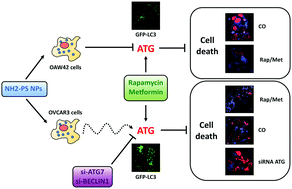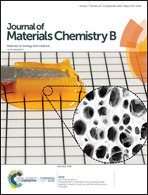Autophagy-dependent toxicity of amino-functionalized nanoparticles in ovarian cancer cells†
Abstract
The use of nanoparticles (NPs) for diagnostic and therapeutic purposes involves the risk of side effects due to the presence of reactive groups on their surface. We studied the cellular stress response to spheroid fluorescent polystyrene nanoparticles (PS-NPs) functionalized with Amino groups in two ovarian cancer cell lines differing in the expression, among others, of relevant proteins involved in endocytosis processes (Caveolin-1) and in pro-survival/pro-death pathways (PTEN and p53). While COOH-PS-NPs were not toxic, NH2-PS-NPs showed dose- and time-dependent toxicity along with the induction of autophagy. In OVCAR3 cells, which are PTEN and P53 mutated and deficient in CAV-1, autophagy was insufficient to protect the cells from NP toxicity. Accordingly, inducers of autophagy were prevented whereas the silencing of autophagy genes exacerbated NP toxicity. In contrast, in OAW42 cells, which express wild-type PTEN, P53 and CAV-1, NH2-PS-NPs strongly limited the formation of autophagosomes, along with an increased production of the mitochondrial anion superoxide and inactivation of ATG4. Preventing the production of the mitochondrial anion superoxide rescued ATG4-mediated autophagy and saved the cells. This study outlines the relevance of the genetic background in the autophagy response to toxicity provoked by NH2-functionalized PS-NPs in cancer cells.



 Please wait while we load your content...
Please wait while we load your content...